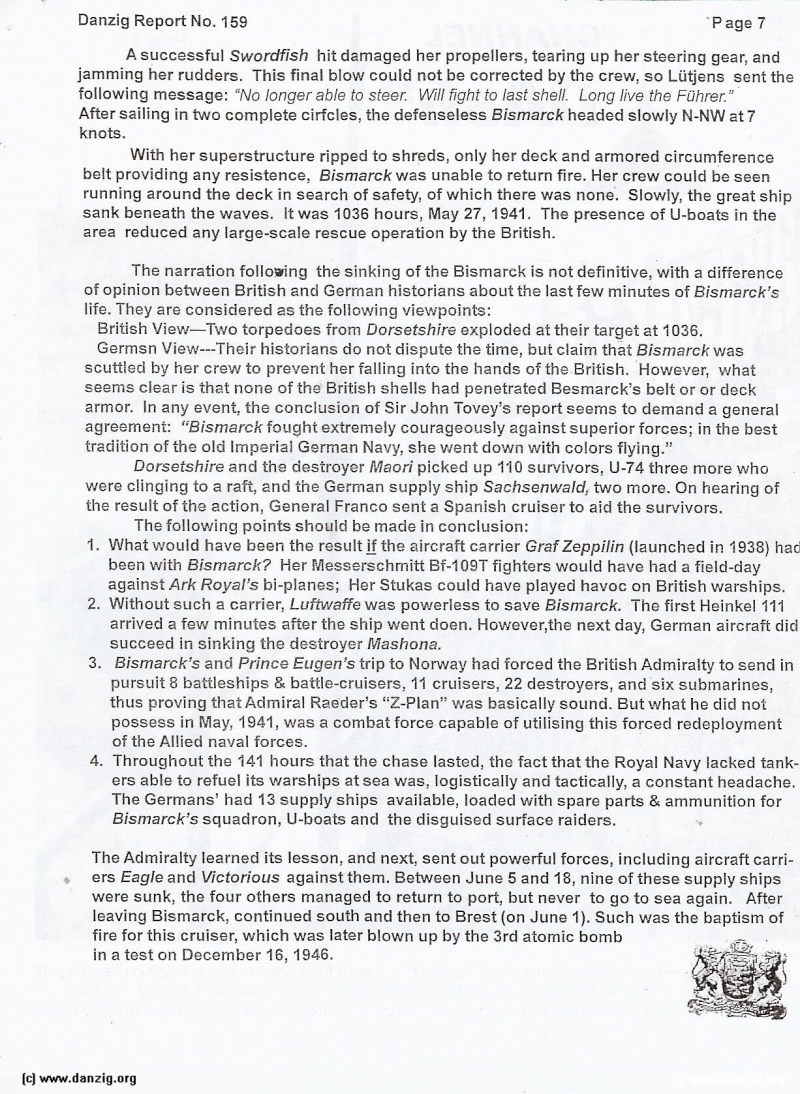
>> Bismarck = Heavily Damaged, Its Steering 90% Gone, She Limps toward Port of Brest, France & repairs.
A successful Swordfish hit damaged her propellers, tearing up her steering gear, and jamming her rudders. This final blow could not be corrected by the crew, so Lütjens sent the following message: “No longer able to steer. Will fight to last shell. Long live the Führer.” After sailing in two complete cirfcles, the defenseless Bismarck headed slowly N-NW at 7 knots.
With her superstructure ripped to shreds, only her deck and armored circumference belt providing any resistence, Bismarck was unable to return fire. Her crew could be seen running around the deck in search of safety, of which there was none. Slowly, the great ship sank beneath the waves. It was 10.36 hours, May 27, 1941. The presence of U-boats in the area reduced any large-scale rescue operation by the British.
The narration following the sinking of the Bismarck is not definitive, with a difference of opinion between British and German historians about the last few minutes of Bismarck’s life. They are considered as the following viewpoints:
British View—Two torpedoes from Dorsetshire exploded at their target at 10.36. Germsn View---Their historians do not dispute the time, but claim that Bismarck was scuttled by her crew to prevent her falling into the hands of the British. However, what seems clear is that none of the British shells had penetrated Bismarck’s belt or or deck armor. In any event, the conclusion of Sir John Tovey’s report seems to demand a general agreement: “Bismarck fought extremely courageously against superior forces; in the best tradition of the old Imperial German Navy, she went down with colors flying.”
Dorsetshire and the destroyer Maori picked up 110 survivors, U-74 three more who were clinging to a raft, and the German supply ship Sachsenwald, two more. On hearing of the result of the action, General Franco sent a Spanish cruiser to aid the survivors.
The following points should be made in conclusion:
1. What would have been the result if the aircraft carrier Graf Zeppilin (launched in 1938) ha been with Bismarck? Her Messerschmitt Bf-109T fighters would have had a field-day against Ark Royal’s bi-planes; Her Stukas could have played havoc on British warships.
2. Without such a carrier, Luftwaffe was powerless to save Bismarck. The first Heinkel 111 arrived a few minutes after the ship went doen. However, the next day, German aircraft did succeed in sinking the destroyer Mashona.
3. Bismarck’s and Prince Eugen’s trip to Norway had forced the British Admiralty to send in pursuit 8 battleships & battle-cruisers, 11 cruisers, 22 destroyers, and six submarines, thus proving that Admiral Raeder’s “Z-Plan” was basically sound. But what he did not possess in May, 1941, was a combat force capable of utilising this forced redeployment of the Allied naval forces.
4. Throughout the 141 hours that the chase lasted, the fact that the Royal Navy lacked tankers able to refuel its warships at sea was, logistically and tactically, a constant headache. The Germans’ had 13 supply ships available, loaded with spare parts & ammunition for Bismarck’s squadron, U-boats and the disguised surface raiders.
The Admiralty learned its lesson, and next, sent out powerful forces, including aircraft carriers Eagle and Victorious against them. Between June 5 and 18, nine of these supply ships were sunk, the four others managed to return to port, but never to go to sea again. After leaving Bismarck, continued south and then to Brest (on June 1). Such was the baptism of fire for this cruiser, which was later blown up by the 3rd atomic bomb in a test on December 16, 1946.
Danzig Report Nr. 159 - 1st Quarter 2013, Page 7.
Hits: 4019
Added: 12/08/2015
Copyright: 2025 Danzig.org

